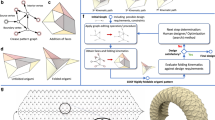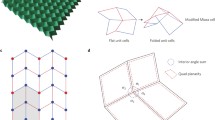Abstract
Folding strategies have been explored in architecture as a method to generate complex spatial and structural concepts from simple planar surfaces. The folding mechanism of a rigid material may seem as trivial as folding a sheet of paper. The striking elegance of models folded from paper appear more than just visually interesting. A simple crease along a line or a curve dictates a determined movement for both faces. The basic origami folds include valley and mountain folds, pleats, reverse folds, squash folds, and sinks. The number of basic folds is small, but they can be combined in a variety of ways to make intricate designs.
Department of Architecture and Urban Studies School of Architecture, Urban Planning and Construction Engineering Politecnico di Milano, Italy (2017)
Access provided by CONRICYT-eBooks. Download chapter PDF
Similar content being viewed by others
Keywords
These keywords were added by machine and not by the authors. This process is experimental and the keywords may be updated as the learning algorithm improves.
Folding strategies have been explored in architecture as a method to generate complex spatial and structural concepts from simple planar surfaces. The folding mechanism of a rigid material may seem as trivial as folding a sheet of paper. The striking elegance of models folded from paper appear more than just visually interesting. A simple crease along a line or a curve dictates a determined movement for both faces. The basic origami folds include valley and mountain folds, pleats, reverse folds, squash folds, and sinks. The number of basic folds is small, but they can be combined in a variety of ways to make intricate designs. Moreover, they inherit positive structural effects and allow for the creation of multiple pieces from one folded sheet, which may save material, fabrication time, and building costs. Hence, the ability to create a structural form from thin, flat materials have made folded structures an ideal candidate for lightweight deployable structures in architecture and engineering.
Within the framework of an interdisciplinary Master studio, led jointly by the departments of Architecture and Mathematics, the students developed, against this background, advanced spatial concepts, based on fairly simple mathematical definitions. The form-finding process started with the research of basic folding principles, both in computational and physical modelling. The individual projects were developed in a bottom-up approach that allowed for the integration of findings throughout the design process.
The Dot & Line project started out with a research on translational and rotational surfaces. Therefore, a straight line was related to a central point by applying various sequences of rotational and translational operation. The resulting 3D models were examined against the constraint of developable surfaces in order to be able to produce an accordingly physical model of the resulting geometry from a flat sheet of paper. The finally chosen circular loop surface was not only a developable surface but also proved to be foldable without cutting an edge of the entire pattern. Hence, the kinetic property is inscribed in the continuity of the surface in such a way that it can adapt to different heights without changing its central diameter. In order to secure this feature in the computational parametric model, the Pythagoras theorem was applied to the rotation of the generating lines around the central point. After testing the principle with a series of paper models a final mock-up was CNC-milled from ACM-boards (diameter: 200 m) as a proof of the concept (Figs. 1, 2, 3, 4, 5, 6, and 7).
The interest in kinetic principles that can be found in folding was the driving force for the research of the project Movement Trajectories. Starting out again from a simple definition of the principle, the group developed a first computational model by defining a rotational movement around a fixed central point, which consequently resulted in a spherical surface. Gradually, the degrees of freedom and the number of points and axis’s were increased in order to generate and control more complex movements. In a final transformation step, the folding control methods were adapted to simple mechanisms by defining two fixed base point, two points with determined trajectories and two points with trajectories defined by intersections with surfaces. As a result from this research, a series of simple mechanisms and systems with movable base points were computed, such as (semi)circular foldable surfaces and umbrella structures (Figs. 8, 9, 10, and 11).
A simple cube served as a starting point for the research Solid Transformations. In a first step, the computational design model was generated by dividing the edges of the cube by n points. The corresponding division points were then connected to generate a rotated square pattern on each face of the cube. The so defined squares were finally extruded and intersected to a unified solid by applying a Boolean operation. Based on this computational parametric model, a series of variation exploring the form generation principle was carried out. The research was concluded by unrolling the 3D surface to a 2D cutting pattern to produce a range of physical models in paper and finally from CNC-milled ACM boards in a bigger scale, as described in the first project (Figs. 12, 13, 14, 15, and 16).
Author information
Authors and Affiliations
Corresponding author
Editor information
Editors and Affiliations
Rights and permissions
Copyright information
© 2018 Springer International Publishing AG
About this chapter
Cite this chapter
Hemmerling, M. et al. (2018). (Un)Folding Space. In: Hemmerling, M., Cocchiarella, L. (eds) Informed Architecture. Springer, Cham. https://doi.org/10.1007/978-3-319-53135-9_22
Download citation
DOI: https://doi.org/10.1007/978-3-319-53135-9_22
Published:
Publisher Name: Springer, Cham
Print ISBN: 978-3-319-53134-2
Online ISBN: 978-3-319-53135-9
eBook Packages: EngineeringEngineering (R0)




















